Spirituality
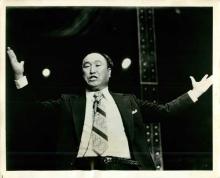
The Rev. Sun Myung Moon, revered as a messiah within his Unification Church but regarded by many others as a vain and enigmatic man who blessed mass weddings, built a sprawling business empire and presided over a personality cult, died on Monday in South Korea. He was 92.
Moon had been in intensive care at a Seoul hospital since Aug. 7, according to his church. The cause of death was complications from pneumonia, including kidney failure.
Moon was born in 1920 in what is now North Korea, and rose from a home in which five siblings starved to death to become an ambitious man who harbored a lifelong hatred of communism, craved respect from the rich and powerful and professed a divine mandate to restore a fallen world.
Apparently you have never really understood the white man’s religion. If you had, you would not have begun your public ministry by calling for repentance. I mean, repentance is radical change, a recognition of guilt, a reversal of its past, an about-face. You can’t expect that from people.
You must have read the multitude of studies that show beyond a shadow of a doubt that no means of communication can do more than make very slight changes. But you talk about “rebirth.” What nonsense! ... You ought to focus on smaller changes that might reasonably be expected. But no. You make outrageous demands that force people to conclude that you are irresponsible.
Spike Lee is not about to give up filmmaking but – at least for a moment or two – he sounded a bit like an expert on the challenges facing the church as he promoted his new movie Red Hook Summer.
“Any church whose members are senior citizens and there’s no youth coming behind, they’re going to die out,” Lee said in a roundtable discussion with reporters.
“Now that goes for synagogues, mosques, temples too — any institution,” Lee continued. “You got to always try to have that infusion of youth. They might not be as smart but youth has energy.”

Editor's Note: This is the fourth installment of Presbyterian pastor Mark Sandlin's blog series "Church No More," chronicling his three-month sabbatical from church-going. Follow the links below to read his previous installments, beginning in June.
- Church No More: Part 1 — Walking Away From Church
- Church No More: Part 2 — Church That Doesn't Steal Your Joy
- Church No More: Part 3 — The 'C' Word
- Church No More: Part 4 — I Don't Want to Go Back
A little over two months ago, I decided I'd spend my three-month sabbatical not going to church. Which might seem like a perfectly normal thing to do – except that I'm a minister. I've had some strange and wonderful experiences which I've written about, but possibly more strange and more wonderful than the experiences are the responses I've received.
From the very beginning the most frustrating response I get is not folks telling me I'll lose my faith if I leave church (and they have), or the ones telling me I can't begin to understand what it's like to be Spiritual But Not Religious (SBNR) in three short months (lots of those were also disturbingly aggressively worded), but rather the ones that say, “Oh, 'sabbatical!' Thanks. Now I have a word to call what I do! I stopped going to church years ago.”
“No!” I'd think while unsuccessfully trying to figure out how to reach through my laptop screen and shake some sense into them, “You are not on sabbatical! The sabbatical I'm taking about has to do with taking a rest, not leaving. It's rest and recuperation — communion with God in a way that is restorative. It's not about leaving! Sheesh.”
More than two months into my sabbatical, I now have to say, “Boy was I wrong.” They are on sabbatical, more so than I am.
 The 2012 Olympic games are approaching quickly. This Friday, more than 10,000 athletes will gather in London to celebrate athleticism and competition in 26 sports. While the hype of an event like this may drive athletes to revel in the spotlight, others find it’s the best avenue for an intimate connection with God.
The 2012 Olympic games are approaching quickly. This Friday, more than 10,000 athletes will gather in London to celebrate athleticism and competition in 26 sports. While the hype of an event like this may drive athletes to revel in the spotlight, others find it’s the best avenue for an intimate connection with God.
At this year’s games, the United States boasts a plethora of athletes, but alongside incredible athleticism, some are gaining attention for their personal faith.

Politically, the right to online privacy seems like a no-brainer. Just as employers, and the government, shouldn’t be allowed to snoop through one’s personal diary or journal, the privacy of our digital records should be likewise respected, in law and in practice.
But biblically, theologically, and spiritually, it gets more complicated. For instance, what would a “spirituality of privacy” look like? At the core of spirituality is a connection with the divine. That begins in our heart of hearts and is by necessity a private, solitary practice. But it doesn’t end there. Genuine, life-transforming spirituality is personal, but never “private,” in the sense of “restricted to me alone.” Rather, spirituality is about the connection between a person and the divine and about the connection between a person and other people. In other words, there is an essential communal, public aspect of spirituality. Genuine spiritual enlightenment leads not only to an enriching of our connection with God, but with one another as well. Thus in some ways the distinction between a “private” spirituality and our public face is an artificial one, and at our best these two aspects of our being will be in harmonious synchronicity.
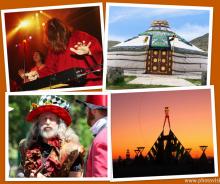
Last year, Phil Wyman, pastor of The Gathering church in Salem, Mass., trekked across the country with five adventurous friends to Burning Man — a week-long event described by its attendees as "an experiment in community, art, radical self-expression, and radical self-reliance" in the Black Rock desert of Nevada.
At the 2011 Burning Man, Wyman and his merry band of "crazy friends" built an art installation called "The Pillars of the Saints" — three meditation towers constructed of wood in the desert, asked people to sit on top of them, listen for a voice (presumably of the Holy), and write what they heard on the walls of the pillars.
This year, Wyman (who you might recognize from photos at the Wild Goose Festival last month where he played the "Holy Fool" in a Sunday morning worship service), has invited more than 15 friends to join him in the Nevada desert at the end of August for Burning Man 2012 where the group plans to build another art installation — this one even more ambitious and whimsical than the last.
Wyman & Co., have christened it "Theophony: The Mighty Interactive Faux Theremin." It involves an enormous, specially-built theremin placed at the center of a 32-foot canvas-and-wood yurt, with walls comprised of a series of 22 four-by-eight-foot murals with themes reflecting the "success and failures of spiritual pursuit."
"The particpant will feel a sense of dissonance while trying to 'play' the theremin," in tune with the chants and ambient music piped through the yurt, Wyman explains. The idea of Theophony is "to illustrate that spiritual pursuit is a discipline, but that even the imperfect attempt is both holy and fun."
SHAKORI HILLS, N.C. — On a swelteringly hot solstice weekend in the southeast, a couple thousand folks gathered in the woods of North Carolina to get their collective goose cooked. An early summer camp like no other, this second annual festival invokes a Celtic image of the Holy Spirit and sparks unlikely convergences inside the great emergence of the contemporary Christian counterculture.
The Goose blends the best of an intellectually engaged faith conference and social justice activist base camp with the sonic frivolity of a modern rock festival and stirs all concepts and collapses all constructs in a steamy potluck stew of primal camp meeting and postmodern tent revival. Without a doubt, the blossoming and beckoning of the Wild Goose movement in North America heralds a bright radical future for today’s Jesus followers bringing the kingdom come.
Wild Goose Festival: Sunday Call to Worship from cathleen falsani on Vimeo.
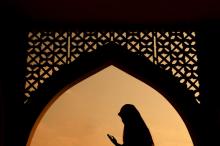
I have been discovering more each day how much I love Muslim people. They are beautiful, warm people, yet we are afraid of them because of misconceptions based on our stereotypes of their race.
I have friends who were living in the Middle East for four years and were sharing about how amazing they find Muslim people. Through my own encounters and my friend’s experiences, here’s what muslim people have taught me.

What matters is human ingenuity. Allow people a window of freedom, and they will fly through it.
They will buy millions of tablet computers as escape from cramped airplane seating and being tethered to desktops. They will create homegrown social networks when Facebook goes weird with their privacy. They will abandon overpriced private colleges, avoid uninspiring suburban housing, and seek investments other than the rigged game of common stocks.
If venture capitalists exact too high a price for startup funding, entrepreneurs will turn to crowd-sourcing. While civic leaders chase yesteryear solutions like industrial parks, real job creators set up shop any old place and work around stuck politicians.
In my work with mainline Protestant churches -- perhaps the most "stuck" of any enterprise -- I see two tracks diverging.
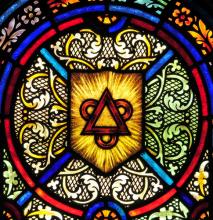
A dear friend recently reminded me of David Ford’s gem of a book, The Shape of Living: Spiritual Directions for Everyday Life. On the back cover, Nicholas Wolterstorff describes it beautifully: “[This book's] spirituality is profound and reflective, yet always concrete, and never dishonest or evasive; it uses not only Scripture but literature with creative facility. Simple, yet rich. A jewel of the spiritual life in its everyday manifestations. I want to savor it with repeated readings.”
Ford traces the “multiple overwhelmings” in our lives — the forces that shake us and shape us, those with the power to wound or crush and those that are life-giving and transformative. At stake in reckoning with such tumult is the whole of our lives and our living. “How,” he asks, ”in the midst of all our overwhelmings, are our lives shaped?”

BIG SUR, Calif. — Perched atop the rugged splendor of the California coast south of Monterey, the Esalen Institute is the mother church for people who call themselves “spiritual but not religious." Over the last five decades, hundreds of thousands of seekers have come to this incubator of East-meets-West spirituality looking for new ways to bring together body, mind, psyche and soul.
But on May 30, as this iconic hot springs spa and retreat center celebrates its 50th birthday, a bitter dispute has broken out over its future. Like the many “seminarians” who come here after losing a spouse or a job, Esalen now faces its own midlife crisis.
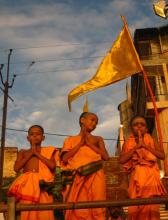
SANTA MONICA, Calif. --- Children are usually the primary complainers about Sunday school, but when Mudita Bahadur started looking for excuses not to take her children to the Hindu temple on Sunday, she knew she had to make a change.
"One, it's dogmatic and two, it's inconvenient," she said of the Hindu classes held a 45-minute drive away from her home in Santa Monica, Calif.
Bahadur decided to take her children's religious education into her own hands. For the past three years, she and other Indian parents have been teaching their children about religion in each other's living rooms.
The do-it-yourself approach permits them to instill pride and progressive values in a traditional manner, the parents say.
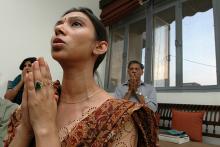
LOS ANGELES -- Even though she met her husband through an arranged marriage, Pooja Sindhwani considers herself a modern woman. She worked in interior design in her native India for four years, and she and her husband spent a year getting to know each other before their wedding. When she followed her husband to Houston, she wasn't worried about adjusting to life in the United States.
"You feel you're going to a country that offers opportunities," Sindhwani said, "you expect that things will work out."
Except when they don't.
Unable to land a job in Houston, Sindhwani slipped into depression. Like thousands of Indian women, she was issued an H-4 "dependent spouse" visa that did not allow her to work.
Sindhwani's husband was a highly skilled foreign worker, sponsored by a U.S. company on an H-1B visa. The Indian women who marry highly skilled workers also tend to be well-educated professionals. Many think it will be easy to transfer from a dependent spouse visa to a work visa.
The constant rejections from companies that couldn't sponsor her work visa took a toll on Sindhwani.
 There's much to contemplate this Holy Week, from Palm Sunday and Maundy Thursday to Good Friday and Resurrection Sunday. Many artists have traveled this path, creating sonic accompaniment for the varied emotions evoked during this sacred week.
There's much to contemplate this Holy Week, from Palm Sunday and Maundy Thursday to Good Friday and Resurrection Sunday. Many artists have traveled this path, creating sonic accompaniment for the varied emotions evoked during this sacred week.
Here are a few tracks that move us, and that we’ll have in heavy rotation throughout until Easter Sunday and beyond, including one of the more unusual Resurrection Day songs you've likely ever heard from the Yeshu Bakhti band Aradhna, pictured at right.
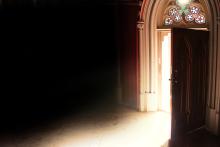
Perhaps you have read Rachel Held Evans' post titled, "15 Reasons I Left Church." With over 800 comments, it has clearly struck a chord with some people. Similarly, Christian Piatt's post on God's Politics, Four Reasons Why I Came Back To Church, has been making the rounds on Facebook. Well, I posted it, at least. They are both about the authors' experiences of being a young adult in relationship with institutional Christianity. It's a difficult topic to write about ... there are trends, of course, but in general the journey is so particular that one cannot really generalize. I think both authors do a good job simply offering up their testimonies, affording the readers an opportunity to make whatever connections we find.
So, in the spirit of connecting the dots, I offer this song and a wee bit of testimony.

Howling wind whipped my long, unruly hair in penitent lashes across my face as I stood in the rain, staring at the churning sea at the northernmost point of Ireland. This place, Malin Head in County Donegal, for some mysterious or mystical reason — perhaps because it is such a broody, dramatic place, or maybe it’s got something to do with ancestry, or both — is the spot I love most in the world.
It is a wild land, the kind of place where myths are born, where giants and saints might come bounding over the next hillock followed by a troupe of little people or a herd of magical sheep.
Whatever the reason, I feel at home here and have returned time and again over the last 15 years, drawn to stand on its rocky cliffs like water to the shore.
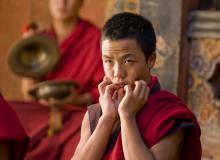
THIMPHU, Bhutan — In a country that prides itself on measuring quality of life in terms of "Gross National Happiness," this small Buddhist kingdom in the Himalayas seems to have a problem: at least half its citizens aren't happy, according to its own measurements.
While more than 90 percent of the 7,142 respondents said they were "happy" in a recent government survey, only 49 percent of people fit the official definition of total happiness by meeting at least six of the survey's nine criteria.
Bhutan's fourth king, Jigme Singye Wangchuck, coined the phrase GNH in 1972 on the belief that people's happiness did not depend on the nation's economic wealth alone.
GNH indicators -- as opposed to more traditional measures like a nation's gross domestic product based on economic activity -- recognize nine components of happiness: psychological well-being, ecology, health, education, culture, living standards, time use, community vitality and good governance.